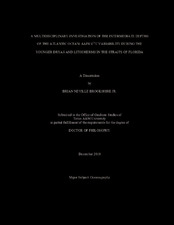| dc.description.abstract | A transect of cores ranging from 798 m to 1585 m water depth in the South Atlantic
Ocean document the relative intermediate water mass nutrient geometry and stable
isotopic variability of AAIW during the Younger Dryas cooling event. The data reveal
concurrent delta^13 C and delta^18 O excursions of 0.59 ppt and 0.37 ppt within the core of
Antarctic Intermediate Water (AAIW) centered at 11,381 calendar years before present
based on radiometric age control. A portion of the delta^1 3C variability (0.22 ppt) can be
explained by a shift in thermodynamic equilibrium concurrent with a drop in
temperature of 1.8°C at the locus of AAIW formation. The remaining 0.37 ppt increase
in delta^13 C most likely resulted from increased wind velocities, and a greater coupling
between the ocean and the atmosphere at the locus of AAIW formation (increased
efficiency of the thermodynamic process).
Deepwater coral mounds are aggregates of corals, other organisms, their skeletal
remains, and sediments that occur on the seafloor of the world’s oceans. In the Straits of
Florida, these features have been referred to as lithoherms. We use digital, side-scan sonar data collected from the submarine NR-1 from an 10.9 km^2 area at ~650 m water
depth to characterize quantitatively aspects of the morphology of 216. Their lengths,
widths, heights, areas, orientations and concentration on the seafloor have been
determined. Analysis indicates that the outlines of relatively small to medium sized
lithoherms can be effectively described with a piriform function. This shape is less
applicable to the largest lithoherms because they are aggregates of smaller lithoherms.
Nearly all of the lithoherms studied have axes parallel to the northward flowing Florida
Current, and the heads of 80 percent of these features face into the current. The shape and
orientation of the lithoherms, and evidence of megaripples and scouring in the sonar data
suggest that these features are formed by a unidirectional current.
Following an extensive investigation of over 200 lithoherms via side-scan sonar
imagery and direct observation, we have developed a qualitative model for the formation
of the lithoherm type of deep-water coral mounds in the Straits of Florida. Lithoherm
formation can be characterized by four main stages of development: nucleating, juvenile,
mature singular, and fused. Fused lithoherms can form via transverse and/or
longitudinal accretion, however, transverse accretion at the head of the mound is likely
the most efficient mechanism. A comparison of lithoherm spatial relationship to local
bathymetry agrees with previous observations of deep-water coral mound formations
along the levied margins of density flow scour channels. | en |


